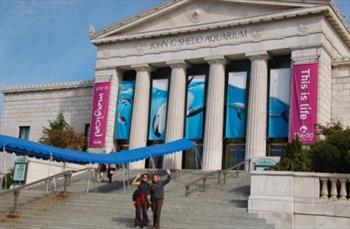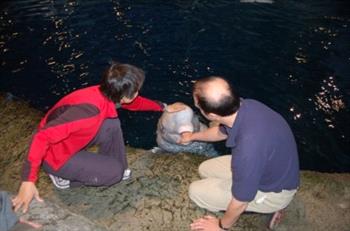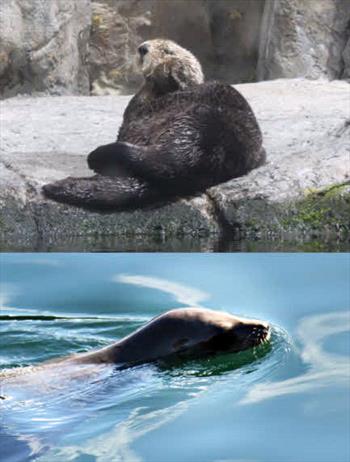Today I had the pleasure of a behind the scenes tour of the Shedd Aquarium in Chicago, just one day after teaming up with Sarah Kalnajs to give a 3-day seminar at Narnia Pet Behavior & Training. The tour was thoughtfully arranged by one of the attendees, Laura Monaco Torelli, a Karen Pryor Academy graduate and former trainer at the Aquarium and current behavioral consultant at the Niabi Zoo. We were accompanied by her friend, Maggie Gonio, another seminar attendee who also had two decades of exotic animal training but at the Brookfield Zoo.
Now, I have never been to the Shedd Aquarium, and all I knew was that the Senior Vice President of Animal Collections and Animal Training, Ken Ramirez had a fantastic reputation for training exotic animals, running the training program at the aquarium, and that he is also a fantastic dog trainer. In fact although I have never met him, he is one of the few people whom I have provided links for on my web site. He runs a 1 week training program at the aquarium once a year for the general public.
The experience was truly amazing. In the 1.5 hour time slot I had prior to leaving to catch my plane, Ken filled my head with a million new facts about the animals and their training.
We started with the sea otters, which are like the Jack Russell Terriers of zoo mammal training. You have to be sharp and quick to keep their attention or they blow you off or get frustrated. Plus they have a low threshold for frustration and when frustrated can become aggressive. Shedd Aquarium’s otters were all rescued as pups. Once orphaned or rescued, they can no longer survive in the wild because their mother plays a crucial role in training them to survive. On another note, for any crazy person who thought it would be fun to have an otter as a pet, illegally, not only are they extremely aggressive they are also more expensive to feed than a beluga whale! So if you harbored a sea otter illegally, you’d be out of house and home due to feeding expenses and possibly medical bills (for yourself). They’d also probably destroy any water home you built for them because they need an incredible amount of enrichment and training or they find destructive ways to entertain themselves. Sounding more and more like a Jack Russell Terrier?
Then there were the sea lions—who, unlike the seals, have ears and wide front flippers that allow them to move easily in water and on land. We met their two newest sea lions—two males who had been slated to be killed because they were depleting the local waters of salmon. When they were captured and brought to the aquarium, they were each 300 pounds overweight. So for those of you who think that animals in the wild just regulate their body weight naturally, keep in mind, that’s because generally in the wild, animals have to work hard to get their food. When food is easy to come by, they can be fat just like our household pets.
The goal with these sea lions is ultimately to get them to be able to live together even though males are generally too aggressive to each other to live together in the wild. Ken’s trained compatibility so many times that he knows this is just a matter of training and time. He’s using a technique that would work well on dogs who don’t get along in a household too if owners would actually follow the protocol like we ask them to. The two males are always kept separate physically such that they can’t even see each other, except during training sessions when they are separated only by a metal barrier. During training sessions each male has a trainer who rewards him for specific behaviors and rewards him for being calm around the other sea lion. If one starts to bicker with another, the trainers just wait the aggression out while safely standing behind a physical barrier. The two sea lions can’t contact each other physically so there’s not threat of injury, plus they do not retreat, rather they remain fairly stationary. Then when one finally focuses back on the trainer, the trainer rewards with food.
Predators that taste the frog, spit it out due to the bad taste and will die if they eat the frog. So what keeps the population of these deadly frogs in check? They do have at least one predator, a snake, who can withstand the toxin.
Indigenous people of Columbia use the frog toxin to lace the tip of their arrows. The toxin is 15x more potent than curare, an arrow poison used by natives of South America. Curare comes from plants.
Next, Ken put one of the male sea lions through his tricks. He barked on cue, spun, tapped his hind flipper, bowed, jumped and pretty much did anything your dog could do. In fact, Laura informed me that her friend referred to sea lions as sea dogs due to their dog-like personality. One particular fun trick was that the sea lion had been trained to mimic humans. So if an audience member were to perform a trick that he knew, such as spin or jump or bow, he would do the same behavior. He hadn’t been trained the actual concept of imitate. Rather he had been trained that these visual movements were his cue to perform those specific behaviors. But the result was cute anyway.
Lastly, we had a close encounter with a Beluga whale. Shedd Aquarium has eight of them and they are able to breed well in captivity. One interesting characteristic of the Beluga whale is that they love to play. So immediately when we arrived, one of younger females came up and solicited tongue rubs from Ken. Beluga’s love having their tongues rubbed. Ken postulates that it feels good because it’s similar to the feel they get when they sift through the sand in search of food. Trainers at Shedd Aquarium use the tongue rub as a reward and the whales must be trained to be gentle. When they are young, they quickly learn that if they clamp down and then release their mouth, the trainer will go away, ending the attention session. This clear message motivates them to form a habit of being gentle.
All in all it was a magical hour and a half. I highly recommend that everyone who visits Chicago visit the Shedd Aquarium. All of the mammals have multiple training sessions a day and the training sessions are narrated by docents. It will give you a new appreciation for the husbandry training that can and should be done in all zoos.
To find out more about Sea Otters and Sea Lions, visit sheddaquarium.org.








